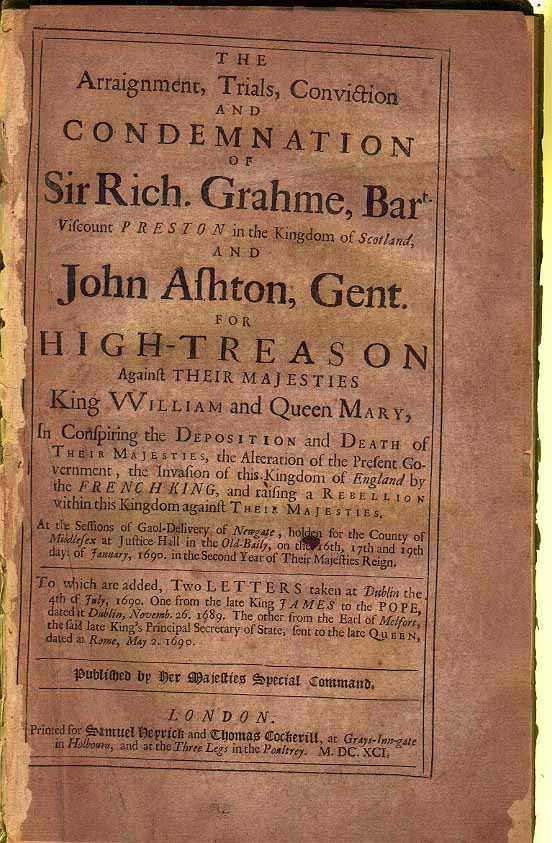John
Ashton and Sir Richard Graham (Viscount Preston), two Protestant Jacobite conspirators;
also Henry Hyde (Earl of Clarendon), George Legge (Baron Dartmouth), William
Penn (founder of Pennsylvania) and Francis Turner (Bishop of Ely), implicated
in the conspiracy.
The Glorious Revolution of 1688, which forced James II into abdication
and exile, is generally regarded as having been provoked by the King's adherence
to Catholicism. The fact that some of James's champions were Protestants is
often overlooked. In 1690 a meeting of Jacobite Protestants decided to ask Louis
XIV of France to send armed forces to England with the purpose of reinstating
James as king. John Ashton (d. 1691) and Richard Grahame (1648-1695) were two
of the main conspirators. Ashton, together with Major Elliott, a young friend
of Ashton's, attempted to hire a boat to take the three men to France, but their
activities invited suspicion and they were arrested (on January 1st, 1691).
They were tried separately and sentenced to death, but only Ashton was actually
executed.
Ashton's loyalty to James arose from the fact that he had
been clerk of the closet to James's wife. Though a Protestant, he declared himself
happy to die in the king's cause. After his death, his wife (also a Protestant)
went to live at the king's court in exile (at St. Germains) but, though James
conferred a baronetcy on her, she was harshly treated for refusing to become
a Catholic.
Graham had received money from Louis XIV to finance
the restoration of King James, and had been arrested and imprisoned for his
political activities in 1689. He was sentenced to death, but pardoned when he
wrote a confession naming his accomplices. These were Henry Hyde (1638-1709),
the Earl of Clarendon, who spent several months in the Tower of London in consequence,
George Legge (1648-1691), Baron Dartmouth, who was also sent to the Tower and
died there later the same year, William Penn (1644-1718), the Quaker founder
of Pennsylvania, who gave himself up, protesting his innocence and was, essentially,
believed, and Francis Turner (1638?-1700), Bishop of Ely, whose loyalty to James
is all the more surprising in that he had been one of the seven bishops arrested
and tried by the king for petitioning for exemption from his order to read the
royal proclamation during church services (they were later acquitted by jury
and released). Turner avoided arrest in the aftermath of Graham's confession,
but his loyalty to James persisted, and he was arrested in 1696 as a nonjurant
activist.

The
book shown here is The
Arraignment, Trials, Conviction and Condemnation of Sir Rich. Grahme ... and
John Ashton, Gent., for High-Treason against ... King William and Queen Mary
... At the Sessions ... holden ... on the 16th, 17th and 19th days of January,
1690 [i.e., 1691; see here for an
explanation of the julian and gregorian calendars]... To which are
added, two letters taken at Dublin the 4th of July, 1690. One from the late
King James to the Pope [requesting assistance in putting down the Revolution]
... The other from the Earl of Melfort ... sent to the late Queen [on
the same subject]... (London, Samuel Heyrick & Thomas Cockerill:
London, 1691. fol., pp. 138.) It is in imperfect condition, quite heavily foxed
and lacking pages 129-34 (replaced with facsimiles), but still a sound, readable
copy.
MARTYRS HOME